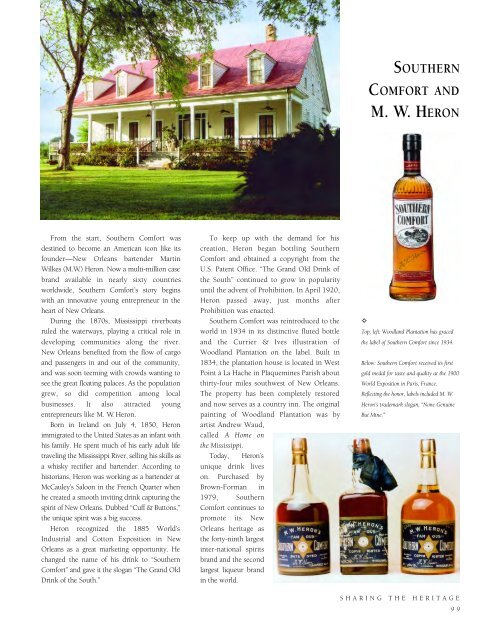Historic Louisiana
An illustrated history of Louisiana, paired with the histories of companies, families and organizations that make the state great.
An illustrated history of Louisiana, paired with the histories of companies, families and organizations that make the state great.
You also want an ePaper? Increase the reach of your titles
YUMPU automatically turns print PDFs into web optimized ePapers that Google loves.
SOUTHERN<br />
COMFORT AND<br />
M. W. HERON<br />
From the start, Southern Comfort was<br />
destined to become an American icon like its<br />
founder—New Orleans bartender Martin<br />
Wilkes (M.W.) Heron. Now a multi-million case<br />
brand available in nearly sixty countries<br />
worldwide, Southern Comfort’s story begins<br />
with an innovative young entrepreneur in the<br />
heart of New Orleans.<br />
During the 1870s, Mississippi riverboats<br />
ruled the waterways, playing a critical role in<br />
developing communities along the river.<br />
New Orleans benefited from the flow of cargo<br />
and passengers in and out of the community,<br />
and was soon teeming with crowds wanting to<br />
see the great floating palaces. As the population<br />
grew, so did competition among local<br />
businesses. It also attracted young<br />
entrepreneurs like M. W. Heron.<br />
Born in Ireland on July 4, 1850, Heron<br />
immigrated to the United States as an infant with<br />
his family. He spent much of his early adult life<br />
traveling the Mississippi River, selling his skills as<br />
a whisky rectifier and bartender. According to<br />
historians, Heron was working as a bartender at<br />
McCauley’s Saloon in the French Quarter when<br />
he created a smooth inviting drink capturing the<br />
spirit of New Orleans. Dubbed “Cuff & Buttons,”<br />
the unique spirit was a big success.<br />
Heron recognized the 1885 World’s<br />
Industrial and Cotton Exposition in New<br />
Orleans as a great marketing opportunity. He<br />
changed the name of his drink to “Southern<br />
Comfort” and gave it the slogan “The Grand Old<br />
Drink of the South.”<br />
To keep up with the demand for his<br />
creation, Heron began bottling Southern<br />
Comfort and obtained a copyright from the<br />
U.S. Patent Office. “The Grand Old Drink of<br />
the South” continued to grow in popularity<br />
until the advent of Prohibition. In April 1920,<br />
Heron passed away, just months after<br />
Prohibition was enacted.<br />
Southern Comfort was reintroduced to the<br />
world in 1934 in its distinctive fluted bottle<br />
and the Currier & Ives illustration of<br />
Woodland Plantation on the label. Built in<br />
1834, the plantation house is located in West<br />
Point à La Hache in Plaquemines Parish about<br />
thirty-four miles southwest of New Orleans.<br />
The property has been completely restored<br />
and now serves as a country inn. The original<br />
painting of Woodland Plantation was by<br />
artist Andrew Waud,<br />
called A Home on<br />
the Mississippi.<br />
Today, Heron’s<br />
unique drink lives<br />
on. Purchased by<br />
Brown-Forman in<br />
1979, Southern<br />
Comfort continues to<br />
promote its New<br />
Orleans heritage as<br />
the forty-ninth largest<br />
inter-national spirits<br />
brand and the second<br />
largest liqueur brand<br />
in the world.<br />
✧<br />
Top, left: Woodland Plantation has graced<br />
the label of Southern Comfort since 1934.<br />
Below: Southern Comfort received its first<br />
gold medal for taste and quality at the 1900<br />
World Exposition in Paris, France.<br />
Reflecting the honor, labels included M. W.<br />
Heron’s trademark slogan, “None Genuine<br />
But Mine.”<br />
SHARING THE HERITAGE<br />
99
















